5 Best Moon Photography Lenses [2024]
by Ryan Hart | Updated on March 5, 2024 | Post may contain affiliate links. As an Amazon Associate we earn from qualifying purchases.
When you want to capture the majesty of a wide, full moon on a summer evening, you need the right lens. Lunar photography can be challenging because often, what we see with our eyes isn’t what the camera captures.
Between planning out your shoot to work around the phase of the moon, its rising and setting times, and the weather, you want to be certain that your camera and lens can deliver the high-quality images you’re looking for. That’s where this guide can help you.
Check out the detailed analysis of each lens below to find the best lens for moon photography.
What is the Best Moon Photography Lens?
If you’re photographing the moon alone, you can get good results with a 200mm or 300mm lens. Still, to fill the frame, you’ll likely want an even longer telephoto lens, or you can use a teleconverter to extend a lens you already own.A 1500mm lens is an excellent choice for the fullest frame and will offer rich, detailed shots.
Here are the best lenses for photographing the moon and getting amazing results.
1. Canon EF 100-400mm f/4.5-5.6L IS II USM Lens
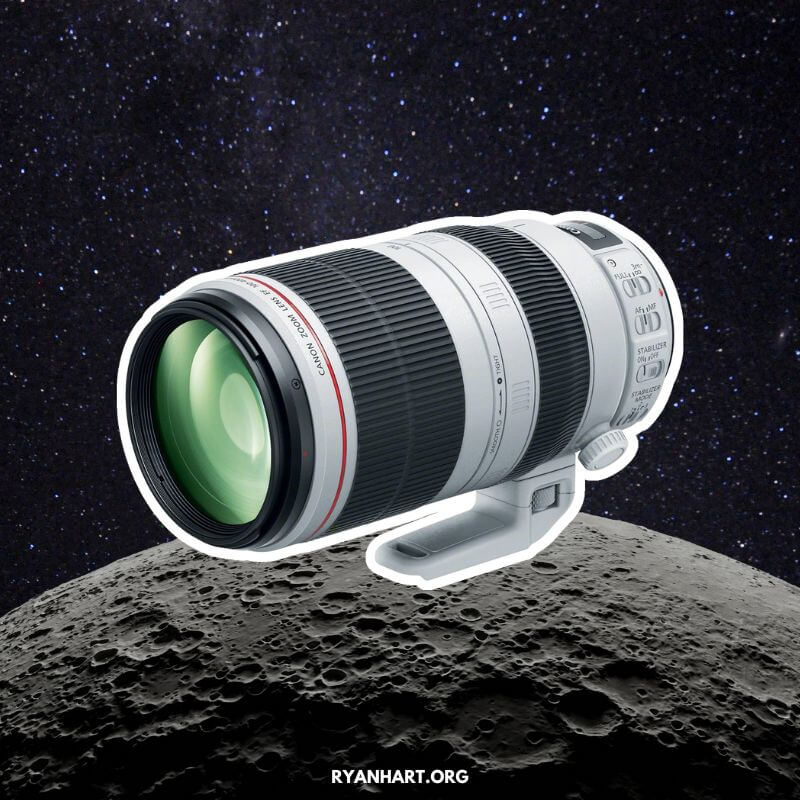
The Canon EF 100-400mm f/4.5-5.6L IS II USM Lens was specially designed for night sky photography that captures your subjects in crisp detail.
Canon is a well-known and loved brand for a reason. They create excellent products, and this lens is no different. The Canon EF 100-400mm is a superb choice for cutting-edge wildlife and nature photography.
Highlights:
- The unique Canon UD element provides great contrast and resolution with minimal chromatic aberration.
- The Air Sphere Coating significantly reduces backlit flaring and ghosting.
- The 9-blade aperture offers soft backgrounds, and the 3-mode stabilizer provides four steps of image correction.
- The telephoto aperture range of four to 5.6 is perfect for close-ups of the full moon, with a 1:3 magnification ratio.
- Since this lens allows you to photograph a far distant object, like the moon, without using a tripod, you can get the perfect shot from anywhere you want, including rocky terrain.
What the Canon EF 100-400mm Does Best:
This lens provides extremely sharp images throughout the zoom range, and the stabilizer helps anyone to create beautiful shots. The focus is reliable throughout the zoom range and fast for capturing spontaneous photos.
Check Prices for the Canon EF 100-400mm Lens
2. Canon EF 75-300mm f/4-5.6 III Telephoto Zoom Lens
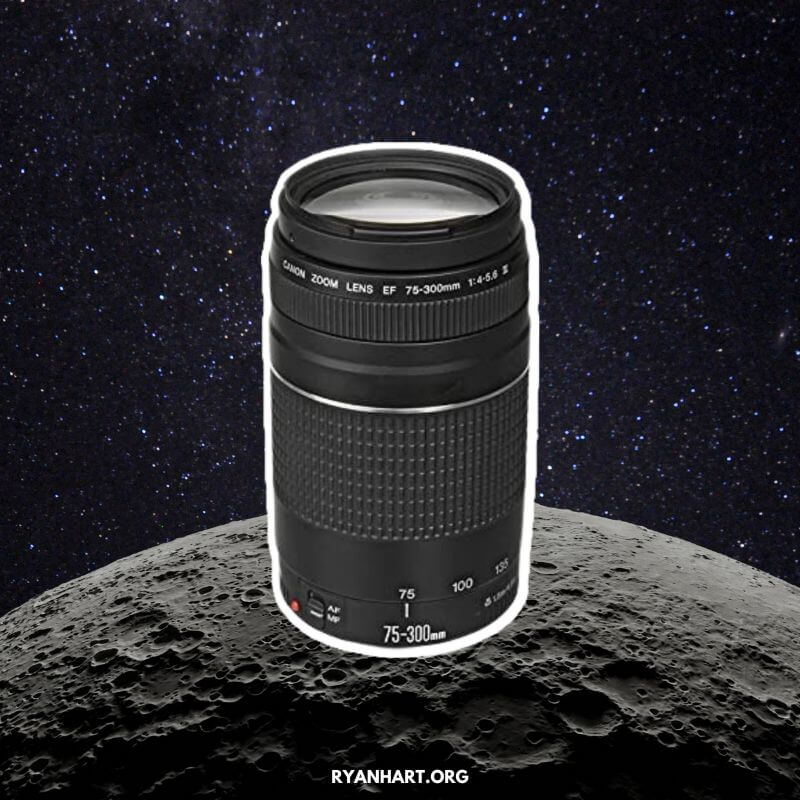
The Canon EF 75-300mm f/4-5.6 III Telephoto Zoom Lensis great for capturing a large landscape with the moon as the focal point. It can be your telephoto and zoom lens with a fantastic aperture that creates lovely blurred backgrounds and works in low-light conditions very well.
For high-contrast shots of the full moon against the dark sky, the Canon EF 75-300mm f/4-5.6 minimizes chromatic aberrations.
Highlights:
- The Canon 75-300mm f/4-5.6 is perfect for shooting high-detail images of celestial bodies, including the moon, stars, galaxies, and more. Because it can shoot out to 300mm, the zoom depth is very impressive.
- The maximum aperture ratio is 1:4-5.6, which makes for a very good telephoto lens that can capture far-off objects like a full moon.
- This lens for moon photography is also a wise choice because it’s great for low-light situations, including dusk and nighttime photos.
- It’ll produce crisp images while remaining lightweight, which is essential if you’re out on location when photographing the moon.
- No flashlights or tripods are required with this long exposure lens.
What the Canon EF 75-300mm does best:
Again, it’s hard to go wrong with a Canon. This telephoto lens is spectacular for long-range, low-light shots, which is exactly what you need for lunar photography.
Check Prices for the Canon 75-300mm f/4-5.6
3. Nikon AF-S FX NIKKOR 200-500mm f/5.6E ED Vibration Reduction Zoom Lens
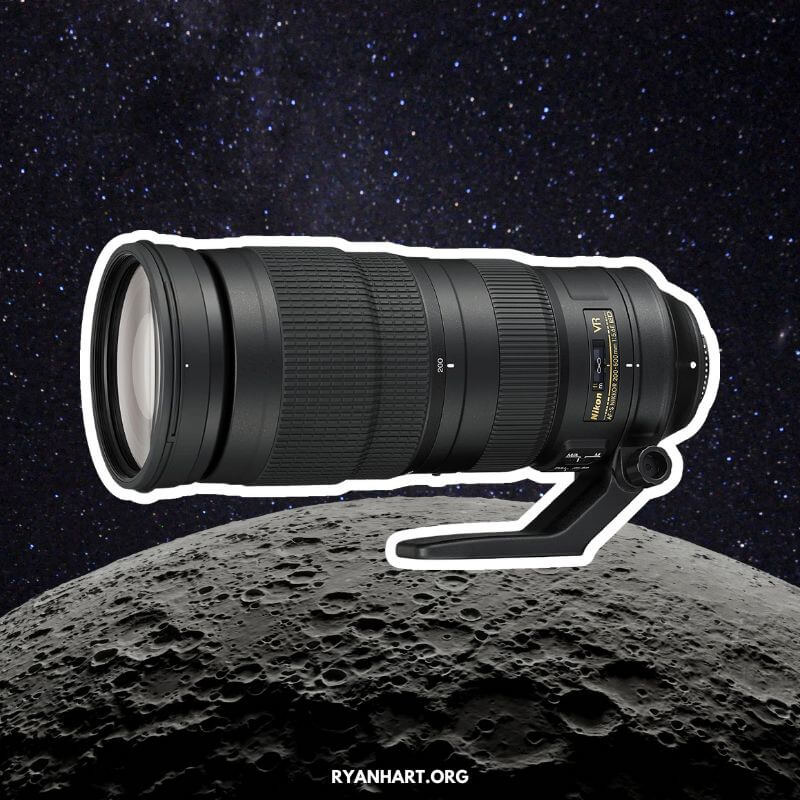
The Nikon AF-S FX NIKKOR 200-500mm f/5.6E ED Vibration Reduction Zoom Lens kicks things up a notch. This DSLR lens has 500 millimeters of zoom power and 4.5 stops of vibration reduction, which can be great when hiking for the best moon shot. It’s very compact and offers soft backgrounds and incredible low-light performance.
Highlights:
- This telephoto zoom lens is perfect for capturing detailed shots of faraway objects. You’ll get soft background across the entire zoom range with reduced lens flare and ghosting.
- The Silent Wave Motor AF system is fast-focusing. It offers enhanced control for spontaneous shots, like clouds passing over the moon in just the right way.
- It’s lightweight and compact for such a powerful lens and keeps images sharp with stabilization features.
- Paired with DX-format cameras, you’ll get an additional 1.5x zoom effect for an angle of view equal to 750mm.
What the Nikon AF-S NIKKOR 200-500mm does best
Nikon is another trusted name in photography. With the Nikon AF-S NIKKOR 200-500mm f/5.6E ED VR, you can get incredible shots of the moon with depth, high contrast, and crisp quality.
Check Prices for the Nikon AF-S NIKKOR 200-500mm
4. Sigma 150-600mm 5-6.3 Contemporary DG OS HSM Lens
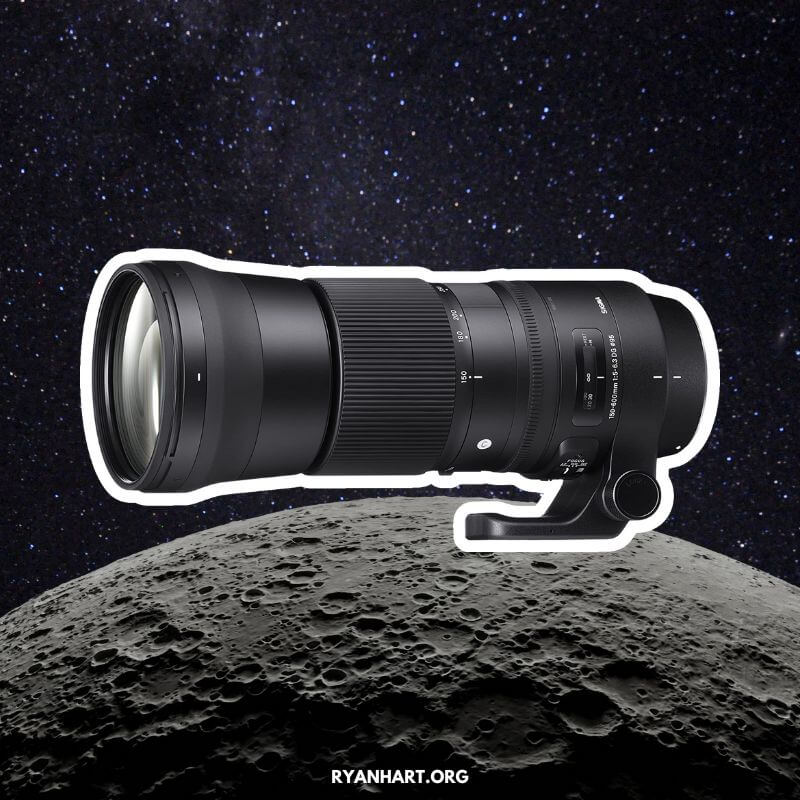
The Sigma 150-600mm 5-6.3 Contemporary DG OS HSM Lensis an excellent choice for those starting out in the industry and looking for the best lens for moon photography on a budget.
It’ll produce sharp images of the moon with great detail and contrast no matter your skill level. The telephoto zoom lens is also excellent for sports or wildlife photography.
Highlights:
- The Sigma 150-600mm Contemporary offers variable aperture in a hyper-telephoto lens. It’s lightweight, compact, and can handle very long reach.
- It offers the latest Sigma technology, including a Hyper Sonic Motor that’s quiet and optimized for long-range shooting.
- The optical stabilizer has an accelerometer that improves panning photography vertically and horizontally.
- The zoom lock can be set for any focal length, and it has a new manual override for making adjustments for improved focusing.
- The SIGMA Optimization Pro updates lens firmware and is USB-dock compatible.
What the Sigma 150-600mm does best
The Sigma 150-600mm Contemporary is an excellent choice for sharp, detailed photos at an impressive zoom. Thanks to the high maximum reach, you’ll be able to capture the moon in the full frame or create a beautiful landscape, incorporating wildlife.
Check Prices for the Sigma 150-600mm Contemporary
5. Sony FE 200-600mm F5.6-6.3 G OSS Super Telephoto Zoom Lens
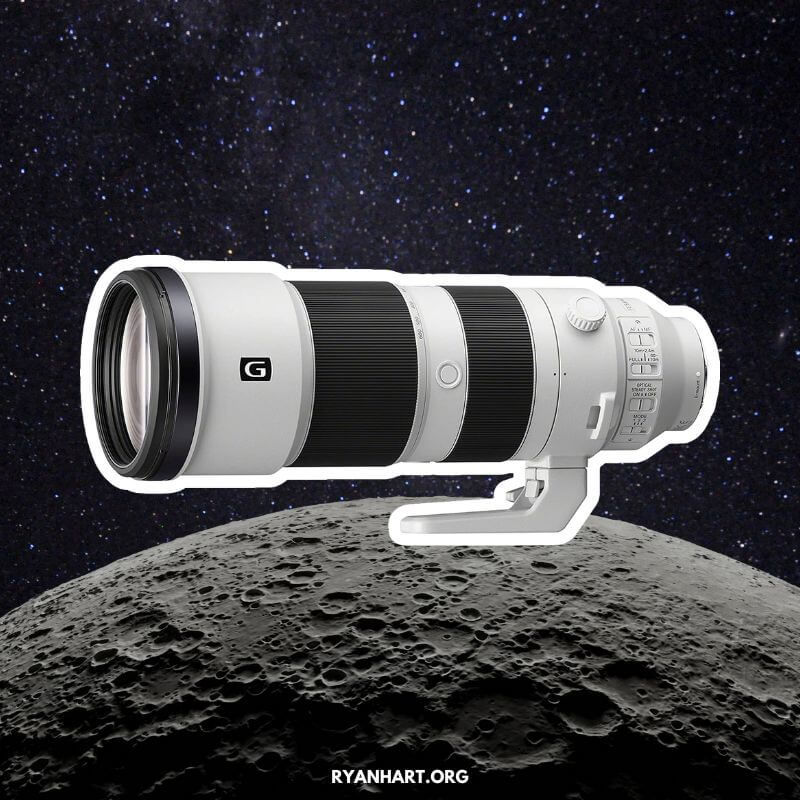
The Sony FE 200-600mm F5.6-6.3 G OSS Super Telephoto Zoom Lensis another excellent lens from a company known for its quality and innovative designs. As one of the highest-end lenses on the list, this telephoto moon photography lens offers incredible resolution throughout the entire zoom range. It’s versatile and offers excellent image quality for all your full-frame moon photos.
Highlights:
- The Sony FE 200-600mm lens offers amazing quality with extra-low dispersion glass elements and an aspherical element for minimal chromatic aberration and sharpness from corner to corner.
- The Nano AR coating minimizes ghosting and flare as well.
- The incredible zoom range is sharp all the way to the maximum depth, and the DDSSM delivers fast, precise, and quiet autofocusing and capture.
- The 11-blade aperture adds beautiful bokeh to the backgrounds, even using the narrow depth of field at the super-telephoto lengths.
- Because it’s so fast and quiet, it’s great for wildlife moon photography when you want to capture birds and other animals along with a gorgeous full moon.
What the Sony FE 200-600mm does best
The Sony FE 200-600mm is an excellent high-quality lens that is perfect for mid-range to established professional photographers. The internal zoom mechanism is a customer favorite throughout reviews and provides stability on such a long lens.
Check Prices for the Sony FE 200-600mm
How to Take a Picture of the Moon
A DSLR or mirrorless camera will provide the best moon photographs, but even a smartphone can produce great images with the right settings.
Once you have your camera ready, you’ll need to find a clear night sky with minimal light pollution. The moon will be brightest when it is closest to the horizon, so try to position yourself accordingly.
If you’re using a DSLR or mirrorless camera, then set your focus to manual and turn off autofocus. Then, use your camera’s live view function to zoom in on the moon and adjust the focus until the image is sharp.
Finally, take the picture! For best results, use a tripod and set your shutter speed to 1/500 or higher. With a little practice, anyone can capture stunning images of the moon.
Frequently Asked Questions
What is a Moon Photography Lens?
A moon photography lens is a special type of lens that is designed for taking pictures of the moon. Moon photography lenses typically have a long focal length, which allows them to capture a lot of detail.
They also usually have a large aperture, which helps to reduce the amount of time that is needed to expose the film or sensor to the light.
Moon photography lenses can be very expensive, but they are worth the investment if you want to take high-quality pictures of the moon.
How does focal length affect moon photography?
Focal length plays a crucial role in moon photography, significantly affecting how the lunar surface appears in your images. For photographers using a full frame camera, a longer focal length is essential to capture detailed, close-up images of the moon. Typically, lenses with focal lengths of 300mm or longer are recommended for moon shots because they allow you to fill the frame with the moon, capturing fine details on the lunar surface that are not visible with shorter focal lengths.
On the other hand, using a wide-angle lens, which has a shorter focal length, results in the moon appearing very small within the frame. Wide-angle lenses are more suited for capturing the moon within a landscape, giving context to its position and size relative to the surroundings rather than focusing on surface details.
For optimal results, especially when using long focal lengths, image stabilization becomes crucial. This feature helps to minimize camera shake and is particularly important in low-light conditions and when shooting at slower shutter speeds to ensure sharp, clear images of the moon. Additionally, the use of a tripod is highly recommended to further stabilize the camera for these kinds of shots, helping to prevent blurring and enhancing the overall clarity and detail of the moon in your photographs.
Can I use a telephoto lens for capturing detailed images of the moon?
Yes, using a telephoto lens is ideal for capturing detailed images of the moon. Telephoto lenses, often referred to as “big lenses” due to their long focal lengths, are perfect for moon shots because they can magnify distant subjects like the moon, allowing you to capture it as if it were much closer. When aiming to photograph just the moon and its surface details, a telephoto lens with a focal length of at least 300mm is recommended, but lenses with focal lengths of 600mm to 800mm or more are even better for achieving high levels of detail.
When using such large lenses on your camera body, it’s crucial to manage issues like camera shake. Image stabilization becomes a key feature in this scenario, helping to reduce blur caused by the slight movements of the camera, especially at slower shutter speeds. Additionally, using a tripod provides the necessary stability for these long lenses, ensuring that the camera remains steady during the shot.
To further enhance sharpness and prevent any vibration from pressing the camera button, using a remote shutter release is advisable. This tool allows you to take photos without touching the camera, minimizing shake and maintaining a crisp image. Adjusting the shutter speed is also important; a faster shutter speed helps to freeze the motion and avoid blur, capturing the moon’s surface with clarity and detail. With the right setup, including a powerful telephoto lens, stable camera support, and careful handling of shutter speed and stabilization, you can take stunning, detailed photographs of the moon.
What settings should I use with my lens to get clear moon photos?
Capturing clear photos of the moon, especially when focusing on only the moon itself, requires precise camera settings. Here’s how to set up your camera and lens to get the best moon images:
Lens and Camera Selection: Use a big lens with a long focal length (at least 300mm) on a full frame camera body to achieve a large, detailed image of the moon. This combination is ideal for isolating the moon and capturing its surface details.
Aperture: Set your lens to a medium aperture around f/8 to f/11. These apertures provide a good balance between letting in enough light and maintaining sharpness across the image.
Shutter Speed: The moon is a moving object due to the Earth’s rotation, so a faster shutter speed is necessary to prevent motion blur. Start with a shutter speed of around 1/125th to 1/250th of a second and adjust as needed based on the brightness of the moon and your camera’s performance.
ISO Setting: Keep the ISO as low as possible to reduce noise in the image. An ISO of 100 to 200 is typically sufficient, especially if your aperture and shutter speed are well balanced.
Focus Mode: Set your lens to manual focus. Autofocus can sometimes struggle under low light conditions or when the subject has few contrasting features, like during a crescent moon phase. Use live view mode and zoom in digitally to finely adjust the focus manually until the moon’s features are sharp.
Image Stabilization: If your lens and camera bodies offer image stabilization, it can be helpful, especially if you’re handholding the camera. However, if you’re using a tripod (which is recommended), it’s best to turn off stabilization as it can sometimes introduce blur when the camera is already stabilized.
Use a Tripod and Remote Shutter Release: To maximize stability, use a sturdy tripod and a remote shutter release to eliminate any potential camera shake from pressing the shutter button manually.
These settings provide a starting point, but you may need to adjust them based on the specific conditions of your shoot, such as the phase of the moon and local atmospheric conditions. Experimenting with these settings during different nights can help refine your technique for moon photography.
Bottom Line
A telephoto lens is a type of camera lens that allows you to take images of distant objects with greater detail than a standard lens.
When taking pictures of the moon, a telephoto lens can be especially useful for capturing close-up shots of craters and other surface features.
In addition, telephoto lenses typically have a large maximum aperture, which means they can gather more light than a standard lens. This is important for taking pictures of the moon, since the moon is often quite dimly lit.
Finally, telephoto lenses have a relatively long focal length, which means they can magnify the image of the moon, making it appear larger in your photo. For all these reasons, using a telephoto lens is the best way to capture clear, detailed photos of the moon.

Ryan Hart is a licensed insurance agent, writer, and former home designer. He is on a mission to help couples protect their homes in retirement with life insurance and annuities.
Want to connect with Ryan? Click here to get his FREE retirement planning newsletter
